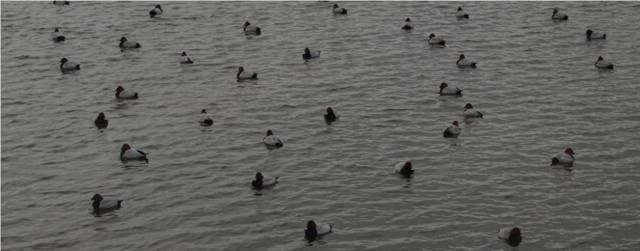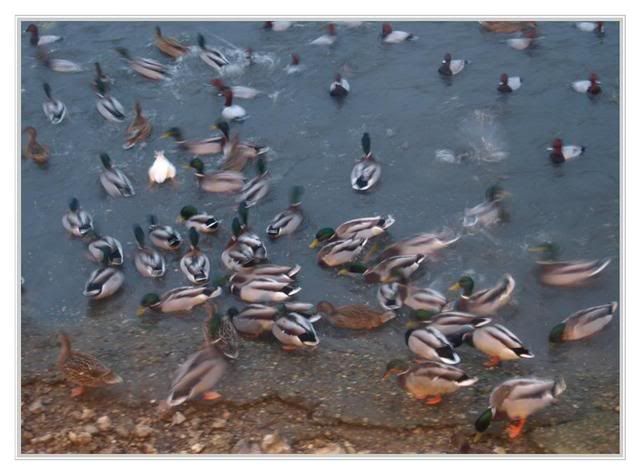First public even of the year, and a chilly afternoon on the estuary. We’re doing a joint bird-watching thing, between the Council Rangers, RSPB and my own organisation, looking at what is on the estuary and beach to the west of my village. I guess it’s pretty good, having two nature reserves nearby – this is the ‘lesser’ one, the Local Nature Reserve(LNR). LNRs are a way the local Council can protect anything interesting, and help prevent the constant degradation of habitat that seems to be a feature of our world.
So we set out in a chill wind, enough to bring tears to the eyes. I (being of limited mobility) took up post on the river, to check on whatever turned up on the inland section, while the rest headed over the dunes to the beach and the mouth of the river, braving the wind-whipped sand and sea spray.
It’s a place where people come to walk their dogs, and they were present in abundance – from small jovial terriers to aloof lurchers, juvenile retrievers that growled at me as a ‘new & therefore weird’ person, springer spaniels that leapt into the river with a joyful bark and a constantly wagging tail, senior sheepdogs that try to round everyone else up – the prevalent smell in the cars heading homeward must be ‘wet dog’…
Some of the owners are responsible, cleaning up the mess after their pooches dump last night’s dinner. But many don’t seem to feel it’s a problem – you would think that, coming here day after day, they would notice the build up of dog crap around the site, but they seem to have selective vision. Indeed, a local councillor has been reported as saying ‘Well, the bin isn’t near where my dog does its business.’ Good example, guys.
So the place is pretty much a ‘watch where you walk’ endeavour, and even the responsible owners aren’t entirely blameless – I watched a guy with three dogs on leads and three running loose… the ones on leads he cleaned up after…the others had done their thing before he got to where I was standing, and of course he didn’t know they had dumped by then…I do wish people would be aware of what their animals were doing when not under their immediate control, as this would prevent a lot of confrontation between visitors and managers of sites…
Sigh. Enough of crap. Literally. Just clear it up, that’s my view.
There weren’t too many birds around – gulls, crows, jackdaws – last year, we did this walk a month later and there were quite a lot of waders – but this could have been a factor of the tide.
Today was the day after a high spring tide, and coupled with a lot of recent rain, the estuary was pretty full. You expect the tide to fill, hit the top – slack – and then retreat, but it seems this isn’t the way it goes. Watching the water come and go, using a fence post and several clumps of grass as markers, it became evident that there was much more to it.
The water seemed to go up and down several times, the grass islands flooding and emerging as I watched. What drew my attention to the changes was that I noticed a small mammal making its way across the flow to one of the islands, and then staying there - hiding in plain sight as several dogs went past.
The water slowly rose – eventually there was no more island, and the beastie (which I believe(though I wouldn’t bet my life on it!) was a was a water vole –a rarity these days) made its way to the ‘mainland’- chin up and doggy-paddle, determinedly – to the bank.
While I watched, (being interested in the relatively rare sighting) I became aware that the water levels were rising and falling, almost as if the river and the sea were breathing in and out as it hit the top of the tide…the post in the water emerged, snagged trailing debris and then disappeared, releasing the raft of reeds to drift away downstream. Then it appeared again, my attention drawn that way by the loud ‘plop’ of a little grebe making its way downstream on the tide and diving as it went. Up and down. Islands emerging and drowning. Tides are a much more complex thing than they seem, written down in the black and white of tables.
We all met up again, to swap sightings and comments on the weather. The wind whispered in the reeds, dry stems rattling, and a blue tit foraged amongst the foliage for insects and seeds. A flock of jackdaws took wing over our heads, and, distant and clear, the call of pink-footed geese rang clear on the air. Grey skies and cold winds, and the edge of a rain shower, brought an end to our survey.
Saturday 26 January 2008
Thursday 3 January 2008
Swan Lake
Winter, for me, starts officially with the return of the whooper swans from Iceland.
One of the best places to see them is Welney, a Wildfowl and Wetlands Trust reserve on the Ouse Washes near Ely, so on a chilly, damp day in November ‘07, Mum and I headed down there to visit them; an afternoon feeding session guarantees a good turnout!
The Visitor Centre is new since the last time we were there – it’s very eco-friendly, with a reed-bed water-treatment system, and an excellent café.


Crossing the bridge, you reach the hide – well, I call it a hide, but it’s centrally heated and far more comfortable than any hide has a right to be. It looks out across the flooded Washes – watermeadows that take the brunt of the winter’s rainfall, and managed to provide an ideal habitat for the migrating wildfowl and for summer visitors in their turn. There are three types of swan here – mute swans, whoopers, and the smaller Bewick swans, although the latter don’t come in close, being kept off the grain feed by the other, bigger birds. (At the moment there is also a black swan, an escape from a local collection and rather unexpected!) As well as swans, there are any numbers of ducks. Most of the ones close-in are mallard (the usual village pond ducks) and pochard – these are the rather dapper grey and chestnut chaps.

Duck Fact: And they are nearly all chaps… the males leave the nesting grounds earlier than the females and young, and consequently take the northerly wintering sites, making the females go further south to Spain. (Hardship, girls!!) The males head back to the breeding grounds in Scandinavia at the start of the season, taking up territories ready for the arrival of the females who, of course, have further to come. The boys bustle around, jockeying for position to be in the right place when the warden comes with the grain barrow, prodding and pushing, diving down and popping up, often underneath an indignant swan, with a flurry of bubbles and a shuffle of feathers and a quick dash to avoid an indignant swan beak. The mallard don’t tend to dive, and have their females with them. They are more inclined to simply shove each other aside in the general melee.

As the light dims the swans start to arrive in greater numbers – up to 4,000 of them at the moment – and they start to parade back and forth in front of the hide, all competing for the right to be first at the food. Below us, the floodlights go on, and excitement builds amongst the birds. A sudden rush to the right alerts us to the warden with his barrow of grain; he makes his way along in front of us, casting scoops of grain into the water. All dignity amongst the swans is immediately lost, and the ducks become a feathered frenzy.

Twilight descends, and with it more swans, white shapes in the gloaming winging over our heads with a melodious and melancholy whooping song, slipping down the cold evening air onto the water, greeting each other with bobbing heads and touching beaks, small family groups – parents and this year’s ashy grey young – staying together amidst the growing flock. We stay until it is too dark to see any more, then take the road northwards, to home and bed.
Winter’s here.
One of the best places to see them is Welney, a Wildfowl and Wetlands Trust reserve on the Ouse Washes near Ely, so on a chilly, damp day in November ‘07, Mum and I headed down there to visit them; an afternoon feeding session guarantees a good turnout!
The Visitor Centre is new since the last time we were there – it’s very eco-friendly, with a reed-bed water-treatment system, and an excellent café.


Crossing the bridge, you reach the hide – well, I call it a hide, but it’s centrally heated and far more comfortable than any hide has a right to be. It looks out across the flooded Washes – watermeadows that take the brunt of the winter’s rainfall, and managed to provide an ideal habitat for the migrating wildfowl and for summer visitors in their turn. There are three types of swan here – mute swans, whoopers, and the smaller Bewick swans, although the latter don’t come in close, being kept off the grain feed by the other, bigger birds. (At the moment there is also a black swan, an escape from a local collection and rather unexpected!) As well as swans, there are any numbers of ducks. Most of the ones close-in are mallard (the usual village pond ducks) and pochard – these are the rather dapper grey and chestnut chaps.

Duck Fact: And they are nearly all chaps… the males leave the nesting grounds earlier than the females and young, and consequently take the northerly wintering sites, making the females go further south to Spain. (Hardship, girls!!) The males head back to the breeding grounds in Scandinavia at the start of the season, taking up territories ready for the arrival of the females who, of course, have further to come. The boys bustle around, jockeying for position to be in the right place when the warden comes with the grain barrow, prodding and pushing, diving down and popping up, often underneath an indignant swan, with a flurry of bubbles and a shuffle of feathers and a quick dash to avoid an indignant swan beak. The mallard don’t tend to dive, and have their females with them. They are more inclined to simply shove each other aside in the general melee.

As the light dims the swans start to arrive in greater numbers – up to 4,000 of them at the moment – and they start to parade back and forth in front of the hide, all competing for the right to be first at the food. Below us, the floodlights go on, and excitement builds amongst the birds. A sudden rush to the right alerts us to the warden with his barrow of grain; he makes his way along in front of us, casting scoops of grain into the water. All dignity amongst the swans is immediately lost, and the ducks become a feathered frenzy.

Twilight descends, and with it more swans, white shapes in the gloaming winging over our heads with a melodious and melancholy whooping song, slipping down the cold evening air onto the water, greeting each other with bobbing heads and touching beaks, small family groups – parents and this year’s ashy grey young – staying together amidst the growing flock. We stay until it is too dark to see any more, then take the road northwards, to home and bed.
Winter’s here.
Subscribe to:
Posts (Atom)
